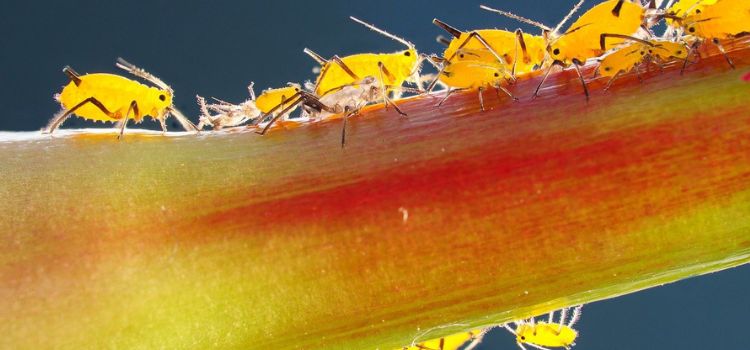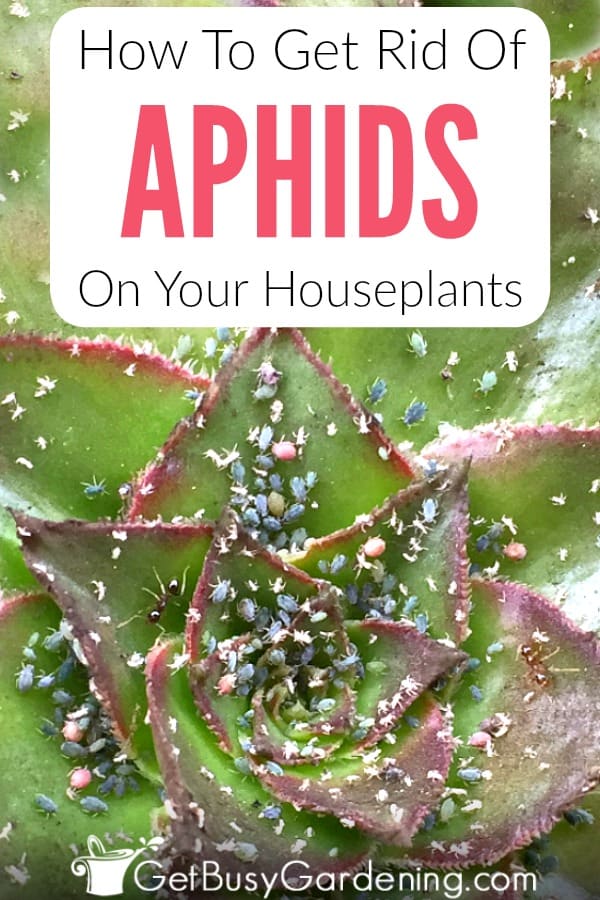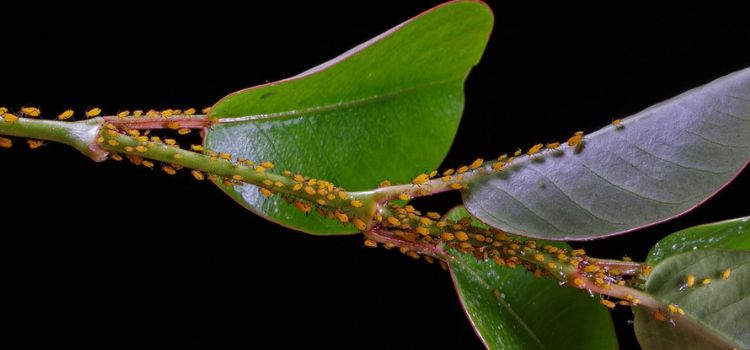As an Amazon Associate, I earn from qualifying purchases.
To get rid of aphids on indoor plants, spray them with a mix of water and mild soap. Ensure thorough coverage of leaves and stems.
Aphids are tiny, sap-sucking insects that can damage indoor plants. Their presence can lead to yellowing leaves, stunted growth, and overall plant decline. Identifying aphids early is crucial for effective control. These pests often cluster on the undersides of leaves and tender new growth.
Using natural remedies like soapy water or neem oil can be effective. Regularly inspecting and maintaining plant health can prevent infestations. Keeping plants free of debris and avoiding over-fertilization also helps. Proper care ensures your indoor plants thrive and stay aphid-free.

Identifying Aphids
Aphids can be a huge problem for indoor plants. These tiny pests can damage leaves, stems, and flowers. They suck the sap from plants, weakening them. Identifying aphids is the first step to getting rid of them. Knowing what they look like and how to spot an infestation is crucial.
Common Types
Aphids come in many types. Here are some common ones:
- Green Aphids: These are the most common. They blend with plant leaves.
- Black Aphids: These are easy to spot due to their dark color.
- Woolly Aphids: These have a white, waxy coating. They look fluffy.
- Yellow Aphids: These are bright and stand out on green plants.
Each type can harm your plants. It’s important to know which one you have. This helps in choosing the right treatment.
Green aphids are often found on roses and houseplants. Black aphids prefer vegetables like beans and peas. Woolly aphids are common on apple trees and some shrubs. Yellow aphids are usually found on indoor plants like hibiscus.
Signs Of Infestation
Aphids leave many signs on plants. Here are some to look for:
- Sticky residue: Aphids produce a sticky substance called honeydew.
- Curling leaves: Leaves may curl or look deformed.
- Yellowing: Leaves may turn yellow and fall off.
- Visible bugs: You might see the tiny aphids on the stems or leaves.
- Ants: Ants are attracted to the honeydew aphids produce.
Sticky residue can lead to sooty mold on plants. This black fungus can cover leaves and block sunlight. Curling leaves make plants look unhealthy. Yellowing leaves can weaken the plant over time. Seeing ants around your plants is a clear sign of aphids.
Always inspect your plants regularly. Early detection can prevent severe damage. Look under leaves and around new growth. Aphids often hide in these areas.
:max_bytes(150000):strip_icc()/control-aphids-on-houseplants-1902889-01-f975f4298a274bd2adf1c08c54934527.jpg)
Credit: www.thespruce.com
Natural Remedies
Aphids are tiny pests that can harm your indoor plants. They suck the sap from the leaves, causing the plant to weaken and die. There are natural remedies to tackle this problem without using harsh chemicals. These solutions are safe for your plants and the environment.
Soap Spray
One of the simplest ways to remove aphids is with a soap spray. This method is effective and easy to prepare at home.
To make a soap spray:
- Mix 1 tablespoon of dish soap with 1 quart of water.
- Pour the mixture into a spray bottle.
- Shake well before use.
Spray the solution directly on the aphids. Ensure you cover the entire plant, especially the undersides of leaves where aphids hide. The soap will kill the aphids by breaking down their outer layer. This causes them to dehydrate and die.
Apply the soap spray every few days until the aphids are gone. Be careful not to overuse the spray, as too much soap can harm your plant. Always rinse your plants with clean water after the treatment.
Neem Oil
Neem oil is another natural remedy for aphid control. It is derived from the neem tree and works as a natural pesticide.
To use neem oil:
- Mix 1 teaspoon of neem oil with 1 quart of water.
- Add a few drops of dish soap to help the oil mix with water.
- Pour the mixture into a spray bottle.
- Shake well before use.
Spray the neem oil solution on the affected plants. Neem oil disrupts the life cycle of aphids, preventing them from feeding, growing, and laying eggs. It also acts as a repellent, keeping aphids away from your plants.
Use neem oil once a week for ongoing protection. It is safe for most plants but always do a small test spray to check for any adverse reactions. Your plants will be healthy and free from aphids with regular use.
Chemical Solutions
Aphids can harm your indoor plants. These tiny insects suck the sap from plants. This can weaken and even kill your plants. Chemical solutions can be very effective in controlling aphid infestations. This guide will help you understand how to use insecticidal sprays and systemic treatments to get rid of aphids.
Insecticidal Sprays
Insecticidal sprays are a common method to kill aphids. They are easy to apply and work fast. Here are some steps to follow:
- Choose a spray that is safe for indoor plants.
- Make sure to read the label carefully.
- Wear gloves and a mask for safety.
- Spray the solution on the affected areas.
- Repeat the treatment every week until the aphids are gone.
It is important to spray both sides of the leaves. Aphids can hide under the leaves. You should also spray the stems and flowers. This ensures that you reach all the aphids.
Here is a simple table showing some popular insecticidal sprays:
| Brand | Main Ingredient | Safety for Indoor Use |
|---|---|---|
| Neem Oil Spray | Neem Oil | Yes |
| Safer Brand Soap | Potassium Salts of Fatty Acids | Yes |
| Bonide Pyrethrin | Pyrethrin | Yes |
Systemic Treatments
Systemic treatments are another effective method. These treatments work from the inside out. They make the plant itself toxic to aphids. Here is how to use them:
- Purchase a systemic insecticide.
- Follow the instructions on the package.
- Water the plant as usual, mixing the insecticide with water.
- The plant absorbs the insecticide through its roots.
Systemic treatments have several advantages. They provide long-term protection. This means you do not have to apply them as often. They also reach aphids hiding in hard-to-reach places. This includes inside buds and new shoots.
It is crucial to use these treatments carefully. Overuse can harm your plants. Here is a simple table showing some popular systemic treatments:
| Brand | Main Ingredient | Safety for Indoor Use |
|---|---|---|
| Bayer Advanced | Imidacloprid | Yes |
| Ortho MAX | Acetamiprid | Yes |
| BioAdvanced 3-in-1 | Imidacloprid | Yes |
Preventive Measures
Aphids are tiny pests that can wreak havoc on indoor plants. They suck the sap from leaves and stems, causing damage. To keep your plants healthy, it’s important to take preventive measures. This guide will help you understand how to get rid of aphids and keep them from coming back.
Regular Inspections
Regular inspections are key to preventing aphid infestations. Check your plants weekly to catch problems early. Look under leaves and around stems, where aphids like to hide. Use a magnifying glass if necessary. Aphids are tiny and hard to see with the naked eye.
During your inspections, look for signs of aphids, such as:
- Sticky residue on leaves
- Yellowing or curling leaves
- Clusters of small, green or black bugs
If you find aphids, act quickly to remove them. You can use a strong stream of water to wash them off. Alternatively, wipe the leaves with a damp cloth. For severe infestations, consider using insecticidal soap.
Maintaining a clean environment also helps. Remove dead leaves and debris from the soil. Aphids can hide and breed in this material. Keeping your plants well-watered and healthy makes them less attractive to pests.
Companion Planting
Companion planting is a natural way to deter aphids. Certain plants repel these pests. Planting them near your indoor plants can help keep aphids away. Here are some effective companion plants:
| Companion Plant | Effect on Aphids |
|---|---|
| Marigold | Repels aphids with its strong scent |
| Garlic | Natural aphid repellent |
| Chives | Repels aphids and other pests |
| Mint | Strong aroma deters aphids |
Planting these companions around your indoor plants creates a natural barrier. Aphids will be less likely to settle on your plants. Make sure to choose companions that thrive indoors. This ensures they grow well alongside your main plants.
Companion planting is an eco-friendly method to control aphids. It reduces the need for chemical pesticides. It also promotes biodiversity and a healthier growing environment.
Cleaning Techniques
Aphids are tiny insects that love to snack on your indoor plants. They can cause a lot of damage if not controlled. Using proper cleaning techniques can help you keep your plants healthy and aphid-free.
Wiping Leaves
Wiping leaves is a simple and effective way to remove aphids. Use a soft cloth or sponge. Dampen it with water mixed with a drop of mild soap. Gently wipe the leaves. Focus on the undersides of the leaves where aphids like to hide.
Here are the steps to follow:
- Mix water and mild soap in a bowl.
- Dip a soft cloth or sponge into the mixture.
- Wipe both sides of the leaves gently.
- Pay special attention to the undersides of the leaves.
- Repeat this process every few days until the aphids are gone.
Avoid using harsh chemicals. These can harm your plants and indoor environment. Regularly check your plants. This helps you catch any aphid problems early.
Rinsing Plants
Rinsing plants can also help to get rid of aphids. Use a gentle stream of water. This will wash away the aphids without harming the plant. You can do this in a sink, shower, or outside with a garden hose.
Follow these steps:
- Place the plant in a sink or tub.
- Use lukewarm water to avoid shocking the plant.
- Spray the plant gently, focusing on the undersides of the leaves.
- Ensure all aphids are washed away.
- Let the plant dry before returning it to its usual spot.
Rinsing works well for larger plants. Repeat this process once a week. Regular rinsing helps keep aphids at bay. Ensure the plant is well-drained after rinsing to avoid root rot.
Beneficial Insects
Aphids can be a major problem for indoor plants. These tiny pests suck the sap from plants, weakening them and causing damage. One effective way to control aphids is by using beneficial insects. Beneficial insects are natural predators of aphids. They help keep the aphid population in check without the need for harmful chemicals. This method is safe for your plants and the environment. Two of the best beneficial insects for controlling aphids are ladybugs and lacewings.
Ladybugs
Ladybugs are one of the best natural enemies of aphids. They can eat a large number of aphids in a short time. Here are some key points about ladybugs:
- Appearance: Ladybugs are usually red or orange with black spots.
- Diet: Both adult ladybugs and their larvae eat aphids.
- Benefits: A single ladybug can eat up to 50 aphids a day.
Releasing ladybugs in your indoor garden can help keep aphids under control. Make sure to release them in the evening. This gives them time to settle before starting to hunt. Provide a water source for the ladybugs. A shallow dish with water and small stones works well. This helps them stay hydrated and active in your garden. Ladybugs are a safe and effective way to manage aphids naturally.
Lacewings
Lacewings are another excellent choice for controlling aphids. These insects are also known as “aphid lions” because of their appetite for aphids. Some important details about lacewings include:
- Appearance: Lacewings have delicate green wings and golden eyes.
- Diet: Lacewing larvae are the main predators of aphids.
- Benefits: One lacewing larva can eat up to 200 aphids a week.
Introducing lacewings to your indoor garden can greatly reduce aphid numbers. Release them near the plants infested with aphids. This helps them find their prey quickly. Like ladybugs, lacewings also need a water source to stay healthy. You can use the same shallow dish with water and small stones. Lacewings are a fantastic, chemical-free way to protect your indoor plants from aphids.
Caring For Affected Plants
Aphids are small insects that can harm indoor plants. They suck the sap from plants, causing damage. Getting rid of aphids is important to keep plants healthy. This guide will help you care for plants affected by aphids.
Nutrient Support
Plants need nutrients to recover from aphid damage. You can help by giving them the right fertilizer. Choose a balanced fertilizer that has equal parts of nitrogen, phosphorus, and potassium. Here are some tips to provide nutrient support:
- Water the plants well before applying fertilizer.
- Use liquid fertilizer for quick absorption.
- Follow the instructions on the fertilizer package.
- Apply fertilizer every two weeks during the growing season.
Over-fertilizing can harm plants. Always use the right amount. Check the leaves for signs of nutrient deficiency. Yellow leaves may mean the plant needs more nitrogen. Brown leaf tips can indicate too much fertilizer.
Here is a simple table to guide you:
| Symptom | Possible Cause | Solution |
|---|---|---|
| Yellow leaves | Lack of nitrogen | Add balanced fertilizer |
| Brown leaf tips | Too much fertilizer | Reduce fertilizer amount |
Stress Reduction
Plants under stress are more likely to get aphids. You can help reduce stress by providing a good environment. Keep the plants in a place with enough light. Avoid placing them in direct sunlight for too long. Water the plants properly. Over-watering and under-watering can both cause stress. Check the soil moisture regularly.
Here are some more tips for reducing stress:
- Keep the room temperature stable.
- Avoid moving plants too often.
- Remove any dead leaves to improve air circulation.
- Keep plants clean by wiping the leaves with a damp cloth.
Stress-free plants are healthier and can better resist pests. Create a routine to care for your plants. This will help them stay strong and less likely to attract aphids.

Credit: getbusygardening.com
Monitoring Progress
Aphids are tiny insects that can cause major issues for indoor plants. These pests suck the sap from plants, leading to weak growth and even death. Monitoring progress is crucial to ensure that you effectively manage and get rid of aphids. Constant vigilance can help in early detection and treatment, ensuring your plants stay healthy and vibrant.
Regular Checks
Regular checks are essential for keeping aphids at bay. Inspect your plants at least once a week. Look closely at the undersides of leaves and stems. Aphids often hide in these areas. Use a magnifying glass to spot these tiny pests more easily. During inspections, also check for signs of damage. These include yellowing leaves, curling leaves, and stunted growth.
Here are some steps to follow during regular checks:
- Examine new plants before bringing them indoors.
- Inspect the soil surface for any signs of pests.
- Use a flashlight to spot aphids in dark corners.
- Note any changes in plant health or appearance.
Keeping a record of your findings can be helpful. This can be a simple notebook or a digital document. Note the date, plant condition, and any aphid sightings. This will help you track the progress and effectiveness of your treatments.
Adjusting Strategies
Adjusting strategies is crucial as you monitor your plants. If you notice an increase in aphid population, try different methods. Natural predators like ladybugs can help control aphids. You can also use insecticidal soap or neem oil. These are safe for most indoor plants and effective against aphids.
Sometimes, mechanical methods work best. Wipe the leaves with a damp cloth to remove aphids. You can also use a strong stream of water to dislodge them. Ensure that the plant can tolerate the water pressure first. Isolation is another strategy. Keep affected plants separate to prevent the spread of aphids.
Here is a simple table to summarize strategies:
| Strategy | Description |
|---|---|
| Natural Predators | Introduce ladybugs to eat aphids |
| Insecticidal Soap | Spray on plants to kill aphids |
| Neem Oil | Apply to leaves and stems |
| Mechanical Removal | Wipe leaves or use water to remove aphids |
| Isolation | Keep affected plants separate |
Adjust your strategies based on the effectiveness. Keep monitoring and recording your progress. This will help you find the best method to keep your indoor plants aphid-free.

Credit: getbusygardening.com
Frequently Asked Questions
What Are Aphids On Indoor Plants?
Aphids are small, soft-bodied insects that feed on plant sap. They can cause stunted growth and yellowing leaves. These pests reproduce quickly.
How Do Aphids Harm Indoor Plants?
Aphids suck sap from plants, causing yellowing and distorted leaves. They can also transmit plant diseases. Their sticky excrement, called honeydew, attracts mold.
Can Aphids Be Removed Naturally?
Yes, you can use natural methods like neem oil, insecticidal soap, or even a strong water spray. Introducing beneficial insects can also help.
What Are Signs Of Aphid Infestation?
Look for curled, yellowing leaves and sticky residue on plants. You may also see clusters of tiny insects on stems and leaves.
Conclusion
Getting rid of aphids on indoor plants is simple with the right methods. Use natural solutions like neem oil or insecticidal soap. Regularly inspect your plants to catch infestations early. Consistent care will keep your indoor garden healthy and aphid-free.
Happy gardening!

